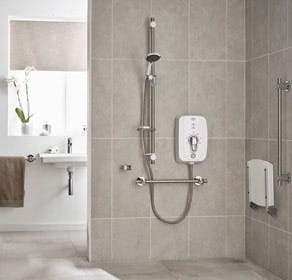With more UK homes requiring bathroom adaptations to meet a variety of needs, installers are frequently required to recommend inclusive showering solutions. Here are some of the key factors that should be considered.
With more UK homes requiring bathroom adaptations to meet a variety of needs, installers are frequently required to recommend inclusive showering solutions. Here are some of the key factors that should be considered.
Finding the right shower
Due to the UK’s aging population, inclusive solutions are now widely fitted within private homes and social housing as well as care establishments, for those who desire independence, privacy and accessible showering.
In multigenerational homes, occupants frequently turn to thermostatic showers as they are suitable for the young and elderly. This type of control delivers an extra level of safety with accreditations such as TMV2/TMV3 and BEAB Care that safeguard the user against temperature fluctuation.
Ease of use is extremely important when providing a comfortable showering solution so familiarity and visual indicators are also key considerations. Products with RNIB endorsement provide the user with colour contrast, a logical visual layout with easy to read markings and tactile surfaces that are ideal for those with varying levels of sight.
Accessories are often required as part of an inclusive bathroom too and small additions can make a big difference. For example, including an extended riser rail coupled with an extra long hose allows seated or standing usage. Alternatively a reinforced riser rail which is load bearing can prove invaluable by doubling up as a grab rail.
For those requiring low level operation in seated amenities, a remote start/stop button provides a real benefit as it can be positioned up to five metres away, simplifying the process for both users and carers as well as providing an additional level of privacy.



